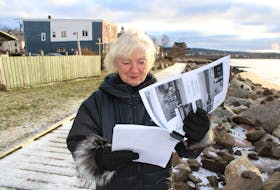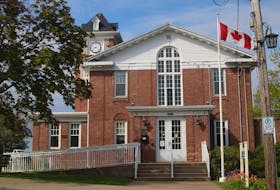Editor’s note: This is part of a weekly series that looks at communities that host Pictou County’s historical kiosks. Historical details are provided by John Ashton.
MERIGOMISH – In the centre of the Merigomish community stands a landmark of days gone by and a symbol of hope for the future.
A former schoolhouse that sat vacant for many years is undergoing major repairs with plans for it to reopen this winter and become a central gathering place for locals.
“The thing around here is if there is a tragedy or someone gets sick, the community comes together, but other than that, people don’t get together at all,” said Pete Radcliffe, a Merigomish resident heavily involved in the renovation project.
The Merigomish community is similar to many other rural areas that were once booming with industry, farming and fishing, but now have become home to retirees or “come from aways” looking for a quieter place to live.
The former schoolhouse first opened in 1879 and is one of only a few landmarks left in the community to remind residents of days long ago.
“A lot of people said tear it down and others said there was a lot of history in it,” Radcliffe said. “Being from away, we weren’t sure which was needed, but when we had the first meeting, we soon found out people were really emotional about it and we said we have to keep this as best we can.”
It is not just the building itself that will gather the community, but it is the work leading up to it that’s making a difference. Many people have volunteered their time and services to help with the renovations which is significantly lowering the cost of the project.
“We need to get it usable and weather-tight,” said Radcliffe.
Overcoming challenges and joining together in times of need have been a common theme in Merigomish for centuries. Settlement was not easy along the shoreline of the Northumberland Strait, but the area continued to thrive.
Merigomish’s earliest inhabitants were the Mi’Kmaq First Nations, but through the years there have been French and Acadian settlements on Big Island and the mouth of French River. Its first permanent settler was Barnabas McGee and his wife Nancy from Pennsylvania in 1776, followed by three more families.
However, its population increased in the mid-1800s when foot soldiers with the 82nd Scottish Duke of Hamilton Regiment were given a large tract of land to settle on.
In the 1870s and 80s, the area was booming with 89 operating farms, four blacksmiths, three sawyers, three joiners, three shoemakers, three merchants, two millwrights, two millers, two shipbuilders, a resident doctor, two religious ministers, a postmaster, a customs officer, a tailor and a justice of the peace.
Several inns, taverns and grog houses operated in the Merigomish area, early in the 19th century and in 1871, the Merigomish area boasted a population of 1,740 people.
The Merigomish Coal Mining Company was formed in the 1880s while several lobster canning factories operated in the Merigomish and Big Island area employing hundreds of local residents until the 1920s.
“It was still a thriving community until 1950, but as the roads got better and people would travel to New Glasgow to work, the community general store gradually lessoned its importance,” said Merigomish native Don Robeson.
Gone now are the old factories and shipbuilding yards and the building that once housed a busy general store is now used for storing a fisherman’s lobster gear.
The post office is still located in the heart of the community, but it isn’t the gathering place it was a century ago. Now people drop in quickly to get their mail and continue on their way home after a commute from a much larger town.
“This community is in transition,” he said. “There are not a lot of old people left and there some new people are coming in.”
He said there are some old family homes still in the area, but names attached to them are not associated with the properties.
“There are four or five families here that actually have husbands working out west,” said Radcliffe, adding the people leaving to work out west are not just young men and women, but those in their 40s and 50s looking to earn some extra money for their retirement.
Yet, despite its rural location, Radcliffe said Merigomish can be a central workplace for those who have access to the high speed Internet and cellphone service.
A self-declared “come from away,” Radcliffe and his wife moved to the area from England and opened a bed and breakfast.
“My wife and I found this piece of land by accident and fell in love with it right away,” he said. “Every day we say, ‘another day in paradise.’”
Robeson said Merigomish has always been in transition, but former residents usually return and sometimes take newcomers with them.
“In my grandfather’s day, they were going to the Boston states to work. That is in the mid to late 1880s. He did. He went to Boston, met my grandma who was from Hants County and brought her back here. Roots take people back. People come back because of their own personal desire to be here.”
Both Radcliffe and Robeson agree that one of the best things about the Merigomish area is that very few people know about its charm.
Robeson said beaches in Arisaig and Big Island are second to none, but are often only used by the locals.
Yet, on the other hand, both men question whether it is better to keep Merigomish one of the province’s best-kept secrets.
“It’s funny talking about getting people to live here,” said Robeson. “I bicycle the Forbes Road most days and a friend of mine, who passed away a year ago, Ron MacIvor, would always chat if I saw him out. I would say, ‘What a wonderful place this is Ronnie.’ He would say, ‘Shhhh… don’t tell anybody.’”
Editor’s note: This is part of a weekly series that looks at communities that host Pictou County’s historical kiosks. Historical details are provided by John Ashton.
MERIGOMISH – In the centre of the Merigomish community stands a landmark of days gone by and a symbol of hope for the future.
A former schoolhouse that sat vacant for many years is undergoing major repairs with plans for it to reopen this winter and become a central gathering place for locals.
“The thing around here is if there is a tragedy or someone gets sick, the community comes together, but other than that, people don’t get together at all,” said Pete Radcliffe, a Merigomish resident heavily involved in the renovation project.
The Merigomish community is similar to many other rural areas that were once booming with industry, farming and fishing, but now have become home to retirees or “come from aways” looking for a quieter place to live.
The former schoolhouse first opened in 1879 and is one of only a few landmarks left in the community to remind residents of days long ago.
“A lot of people said tear it down and others said there was a lot of history in it,” Radcliffe said. “Being from away, we weren’t sure which was needed, but when we had the first meeting, we soon found out people were really emotional about it and we said we have to keep this as best we can.”
It is not just the building itself that will gather the community, but it is the work leading up to it that’s making a difference. Many people have volunteered their time and services to help with the renovations which is significantly lowering the cost of the project.
“We need to get it usable and weather-tight,” said Radcliffe.
Overcoming challenges and joining together in times of need have been a common theme in Merigomish for centuries. Settlement was not easy along the shoreline of the Northumberland Strait, but the area continued to thrive.
Merigomish’s earliest inhabitants were the Mi’Kmaq First Nations, but through the years there have been French and Acadian settlements on Big Island and the mouth of French River. Its first permanent settler was Barnabas McGee and his wife Nancy from Pennsylvania in 1776, followed by three more families.
However, its population increased in the mid-1800s when foot soldiers with the 82nd Scottish Duke of Hamilton Regiment were given a large tract of land to settle on.
In the 1870s and 80s, the area was booming with 89 operating farms, four blacksmiths, three sawyers, three joiners, three shoemakers, three merchants, two millwrights, two millers, two shipbuilders, a resident doctor, two religious ministers, a postmaster, a customs officer, a tailor and a justice of the peace.
Several inns, taverns and grog houses operated in the Merigomish area, early in the 19th century and in 1871, the Merigomish area boasted a population of 1,740 people.
The Merigomish Coal Mining Company was formed in the 1880s while several lobster canning factories operated in the Merigomish and Big Island area employing hundreds of local residents until the 1920s.
“It was still a thriving community until 1950, but as the roads got better and people would travel to New Glasgow to work, the community general store gradually lessoned its importance,” said Merigomish native Don Robeson.
Gone now are the old factories and shipbuilding yards and the building that once housed a busy general store is now used for storing a fisherman’s lobster gear.
The post office is still located in the heart of the community, but it isn’t the gathering place it was a century ago. Now people drop in quickly to get their mail and continue on their way home after a commute from a much larger town.
“This community is in transition,” he said. “There are not a lot of old people left and there some new people are coming in.”
He said there are some old family homes still in the area, but names attached to them are not associated with the properties.
“There are four or five families here that actually have husbands working out west,” said Radcliffe, adding the people leaving to work out west are not just young men and women, but those in their 40s and 50s looking to earn some extra money for their retirement.
Yet, despite its rural location, Radcliffe said Merigomish can be a central workplace for those who have access to the high speed Internet and cellphone service.
A self-declared “come from away,” Radcliffe and his wife moved to the area from England and opened a bed and breakfast.
“My wife and I found this piece of land by accident and fell in love with it right away,” he said. “Every day we say, ‘another day in paradise.’”
Robeson said Merigomish has always been in transition, but former residents usually return and sometimes take newcomers with them.
“In my grandfather’s day, they were going to the Boston states to work. That is in the mid to late 1880s. He did. He went to Boston, met my grandma who was from Hants County and brought her back here. Roots take people back. People come back because of their own personal desire to be here.”
Both Radcliffe and Robeson agree that one of the best things about the Merigomish area is that very few people know about its charm.
Robeson said beaches in Arisaig and Big Island are second to none, but are often only used by the locals.
Yet, on the other hand, both men question whether it is better to keep Merigomish one of the province’s best-kept secrets.
“It’s funny talking about getting people to live here,” said Robeson. “I bicycle the Forbes Road most days and a friend of mine, who passed away a year ago, Ron MacIvor, would always chat if I saw him out. I would say, ‘What a wonderful place this is Ronnie.’ He would say, ‘Shhhh… don’t tell anybody.’”








